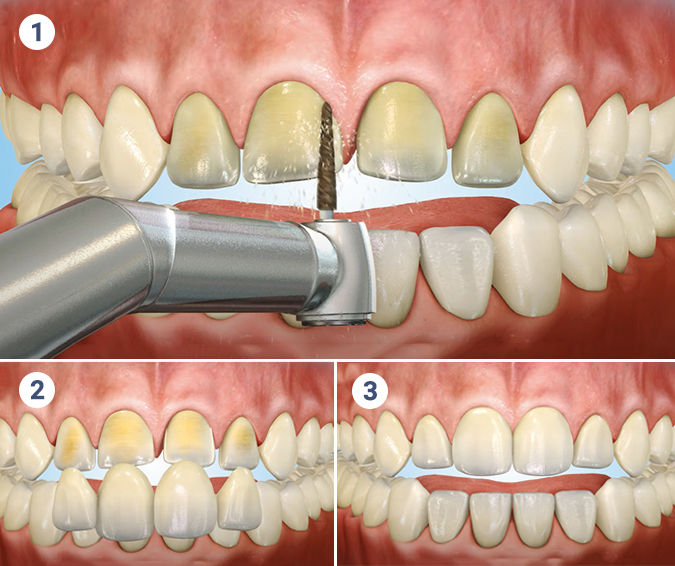Dental Veneers 101: A Step-By-Step Guide to a Flawless Smile
Wiki Article
Veneers 101: Understanding Their Benefits and Exactly How They Transform Your Dental Aesthetics
Veneers are coming to be progressively popular for those seeking to improve their smiles. These slim shells can efficiently address various oral imperfections, from staining to unevenness. Comprehending the benefits of veneers is necessary for anyone considering this transformative alternative. The procedure and selections included can be intricate. What factors should one consider before making a choice? The solutions might stun you.What Are Veneers?
Veneers are slim shells made from porcelain or composite material that are custom-fitted to the front surface of teeth. Veneers Teeth. They are created to enhance the appearance of the smile by resolving numerous dental flaws. Usually, veneers are utilized to deal with problems such as staining, unevenness, and small gaps between teeth. The application process calls for a dental specialist to take specific dimensions and create molds to ensure an excellent fitPrior to placing veneers, a tiny amount of enamel may be removed from the tooth surface area to fit the covering, permitting a natural feel and look. When positioned, veneers can significantly improve the aesthetic appeals of an individual's smile, offering a uniform and intense appearance. People commonly choose veneers for their sturdiness and resistance to spots, making them a preferred alternative for those looking for a long-lasting cosmetic option. On the whole, veneers use a transformative approach to achieving a more attractive smile.
The Advantages of Deciding On Veneers
While lots of cosmetic dental options exist, selecting veneers offers a special blend of visual and sensible benefits. Veneers enhance the look of teeth, offering a natural look that can significantly enhance an individual's smile. They are specifically efficient in addressing issues such as discoloration, chips, and voids, making them a functional remedy for various oral worries.In addition to their visual appeal, veneers are stain-resistant and also long lasting, making them a durable investment in oral visual appeals. With correct treatment, they can keep their appearance for years. The application of veneers needs very little modification to the natural tooth framework compared to other options, maintaining the honesty of the teeth.

The Veneer Application Process
The veneer application process starts with a complete consultation, during which the dentist reviews the client's dental health and wellness and talks about aesthetic goals. This preliminary conference allows the dental expert to examine concerns such as staining, chips, or spaces, and establish if veneers are an appropriate option. When the patient is deemed an excellent candidate, the following action involves preparing the teeth. This may consist of removing a small amount of enamel to guarantee a correct fit for the veneers.Impacts of the teeth are then taken, which are sent out to an oral research laboratory where the custom-made veneers are developed. Throughout this time, a momentary remedy may be provided. After a few weeks, the patient go back to have the long-term veneers fitted. The dental expert checks the fit and shade, making adjustments as needed. Finally, the veneers are bonded to the teeth using a strong adhesive, completing the improvement and enhancing the client's smile.
Types of Veneers: Porcelain vs. Composite
When thinking about cosmetic oral choices, patients frequently consider the benefits of porcelain and composite veneers. Porcelain veneers are favored for their resilience and resistance to discoloration, making them an exceptional lasting service for improving smiles. These slim shells are customized to match the natural teeth, providing a realistic look that numerous find enticing. Furthermore, porcelain mirrors light likewise to all-natural enamel, contributing to an extra authentic look.In comparison, composite veneers are usually cheaper and can be used in a single see. Made from a tooth-colored resin, they use flexibility in shaping and can be easily repaired if damaged. However, they may not last as long as porcelain and are much more vulnerable to staining gradually. Inevitably, the option in between porcelain and composite veneers relies on private visual goals, budget considerations, and the certain dental scenario, directing clients towards the most effective alternative for their requirements.
Maintaining Your Veneers for Longevity
Appropriate maintenance is essential for making certain the longevity of veneers. Normal oral examinations play a considerable role, permitting specialists to evaluate the problem of the veneers and bordering teeth. Good oral health methods, such as brushing two times daily with this page a non-abrasive tooth paste and flossing, aid stop plaque accumulation and keep the overall health of the mouth.
Furthermore, individuals should stay clear of using their teeth as tools, which can jeopardize the honesty of veneers. Limiting the usage of sticky or difficult foods minimizes the risk of damage. It is also suggested to avoid practices like nail-biting or grinding teeth, as these can cause premature wear.
Using a soft-bristled tooth brush and mild mouth wash can better boost veneer care. By following these basic yet efficient upkeep pointers, people can enjoy their veneers' visual benefits for many years to find, guaranteeing an attractive smile that stands the test of time.

Potential Risks and Factors To Consider
Various possible risks and considerations come with the choice to get veneers. To start with, the treatment typically calls for the removal of a thin layer of enamel from the all-natural teeth, which can result in increased level of sensitivity and potential damages if not performed appropriately. Furthermore, veneers are not relatively easy to fix; once used, the natural tooth structure is permanently changed.There is also a risk of veneers chipping or breaking, specifically if the private involves in practices like teeth grinding or attacking hard things. Furthermore, if the underlying tooth creates degeneration after veneer placement, it might complicate treatment options.
Cost is one more consideration, as veneers can be costly and often not covered by insurance policy. Ultimately, individuals ought to know the requirement for continuous maintenance and prospective replacements every 5 to ten years, making it crucial to evaluate these aspects versus the visual benefits veneers offer.
Regularly Asked Questions
How Much Time Do Veneers Usually Last Before Needing Substitute?
Veneers typically last in between 10 to 15 years, depending upon aspects such as oral hygiene, way of living practices, and the find more quality of materials utilized. Normal dental exams can assist assure their long life and ideal condition.Can Veneers Be Eliminated As Soon As Applied?
Yes, veneers can be eliminated as soon as applied (Porcelain Veneers Dentist). However, this process typically calls for professional support, as it includes careful strategies to avoid harming the underlying tooth framework, which might be influenced by the veneer positioningAre Veneers Suitable for Every Person?
Veneers are not ideal for every person. People with significant oral issues, such as severe degeneration or gum illness, may call for alternate therapies. An extensive dental analysis is vital to figure out candidateship for veneer application.Do Veneers Require Unique Dental Products for Cleansing?
Veneers do not call for unique dental products for cleaning; nevertheless, making use of non-abrasive tooth paste and a soft-bristled news tooth brush is recommended. Veneers Teeth. Regular dental examinations and good oral health techniques maintain their appearance and durability properlyWhat Is the Price Array for Obtaining Veneers?
The cost for getting veneers normally ranges from $500 to $2,500 per tooth, depending on factors such as material type, dental expert expertise, and local rates variants. Clients ought to seek assessments for accurate quotes tailored to their needs.
Veneers are thin coverings made from porcelain or composite material that are custom-fitted to the front surface area of teeth. Before placing veneers, a small amount of enamel might be eliminated from the tooth surface to accommodate the covering, allowing for a natural appearance and really feel. Veneers boost the look of teeth, giving an all-natural appearance that can significantly boost a person's smile. Impressions of the teeth are after that taken, which are sent out to a dental lab where the personalized veneers are produced. Regular dental exams play a considerable function, enabling professionals to assess the condition of the veneers and bordering teeth.
Report this wiki page